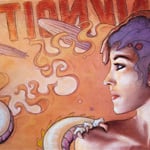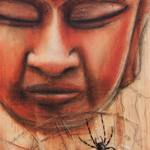Ken is in the process of creating a new teaching called “The Fourth Turning – Imagining the Evolution of an Integral Buddhism.” This teaching is being published as videos and an E-book this year and a new hardcover book in 2015. This blog post is the first excerpt of a summary of this new teaching.
Buddhism has, of all the major religions, always had a very self-reflexive understanding of itself as growing, evolving, unfolding. Nowhere is this better seen than in Buddhism’s own notion of “Three (or Four) Turnings,” the idea that Buddhadharma itself (Buddhist Truth) has gone through three or four major turnings or evolutionary unfoldings, each adding to (but including) the previous turning.
The First Turning
The First Turning was represented by Gautama Buddha himself, the founder of the religion. It came to be expressed most centrally in the Four Noble Truths: 1) Life as we know it is suffering. 2) The cause of suffering is grasping. 3) To end grasping is to end suffering. 4) There is a way to end grasping, namely, the Eight-Fold Way (right view, right intention, right speech, right actions, right livelihood, right effort, right mindfulness, right concentrative awareness).
The Second Turning
Such was the essence of Buddhism for some 700 years, until the Buddhist genius sage Nagarjuna set forth his writings on Shunyata, typically translated as Emptiness (sometimes Nothingness, or the Plenum/Void). Nagarjuna (c. 200 BCE) was increasingly skeptical of this strange dualism between samsara and nirvana (or, essentially equivalent, Form and Emptiness), that was central to Gautama’s teaching, believing rather that ultimate reality had no such dualisms but rather was, to put it somewhat metaphorically, a seamless nondual Whole (seamless, not featureless). The aim, thus, was not to get from one-half of this dualism (samsara) into the other half (nirvana), but to find the seamless Whole (Thatness, Suchness) underlying them. The cause of suffering is not knowing the Real, not knowing Emptiness or Reality in its Suchness, just as it is, free of limiting thoughts and concepts, and that which obscures the Real is drsta, or conceptualizing, qualifying, characterizing. Any concept makes sense only in terms of its opposite—infinite vs. finite, One vs. Many, Form vs. Emptiness, Up vs. Down, Spirit vs. Matter, etc.—and yet Reality has no opposite. In fact, according to Nagarjuna, you cannot say that Reality 1) is, nor 2) is not, 3) nor both, 4) nor neither, and that goes for any concept, any drsta, you can think of. Reality is not 1) infinite, nor 2) not infinite, 3) nor both, 4) nor neither. And so on through any concept, quality, characteristic, or notion you can think of.
Now the point of this fourfold negation—applied across the board—is not just a version of “neti, neti”—“not this, not that”—but to clear the mind from any dualistic thoughts or concepts (vikalpa or “dualistic thinking”) in order to make room for nondualistic awareness (or prajna)—the “jna” in English is “kno”—as in “knowledge”—or “gno”—as in “gnosis”—with “pra” being “pro”—thus, “prajna” is “pro-gnosis,” a nondual form of awareness in which the subject/object dichotomy is transcended—or the self/other dualism is seen through—leaving instead pure, undivided, nondual awareness—although, again, words such as “undivided” or “nondual” are metaphoric at best, since strictly speaking you can’t say this awareness, which is one with Reality, is 1) nondual, nor 2) not nondual, nor 3) both, nor 4) neither.) But the point, metaphorically, is that the dualism between Form and Emptiness, or samsara and nirvana, is mistaken, doesn’t really exist. As the Heart Sutra would summarize this view, “That which is Form is not other than Emptiness, that which is Emptiness is not other than Form,” which also means, “That which is samsara is not other than nirvana, and that which is nirvana is not other than samsara.” The point (again, metaphorically) is that dualities and concepts and qualifications tear the seamless Whole of Reality into torture-inducing, separate slices, and only by overcoming this fragmentation and alienation (via prajna) could a human find Wholeness, peace, freedom, release.
Such a profound notion was Shunyata that this whole approach was called the “Second Turning of the Wheel of Dharma (Truth),” and it marked virtually every subsequent Buddhist school henceforth. Among other things, by seeing that ordinary reality, just as it is, when seen in its Suchness, or Thusness, or Isness, is the same as the liberated state of nirvana, allowed a revolution in Buddhist practice. There is no ontological difference between samsara and nirvana, just an epistemological one—nirvana looked at through drsta is samsara, samsara looked at through nondual awareness is nirvana. Samsara and nirvana are “not-two” or “nondual” (and some schools, such as Zen, to emphasize the real “emptiness” or “nonceptuality” of the Real—and make sure “nondual” isn’t confused with “oneness”—would say they were “not-two, not-one” (which is why the “Wholeness” is metaphoric only; the point is that ultimate Reality can be realized or recognized, but not stated in words, all of which are dualistic and thus misleading).
But (within our metaphorical understanding), this was a profound revolution simply because now ordinary reality is the home of Enlightenment as well—our thoughts, desires, graspings, wishings are all “not-two” with ultimate Reality or Emptiness, and thus we can “bring everything to the path.” This would prove to be the opening to schools of liberation from Tantra to Vajrayana (“Diamond Vehicle,” e.g., Tibetan Buddhism). Such was the Second Turning. And in a crucial move, all of the basics of the First Turning were included—the Second Turning “transcended and included” the First Turning. Various subsequent schools of Buddhism would find ways to include the basic tenets of Gautama’s teachings with those of Nagarjuna’s, thus keeping Buddhism a seamless evolutionary stream. It was said, for example, that Gautama’s teaching on the emptiness of the self simply needed to be complemented with teachings on the emptiness of dharma (thing-events) as well—together, you had the full Emptiness view. So Gautama wasn’t so much denied as supplemented—again, giving Buddhism a very strong sense of evolutionary seamlessness and togetherness, even as new teachings were being introduced.
The very notion of the “not-twoness” of Emptiness and Form opened the door, as we briefly mentioned, to other even “stronger” versions of nonduality or (metaphoric!) Wholeness, one of the most prominent being the Yogachara, introduced by the half brothers Asanga (more of a brilliant innovator) and Vasubandhu (more of an acute synthesizer). Another name for their school—Vijnaptimatra—is usually translated as “Mind-only” or “Representation-only.” The point here is that the “not-twoness” of Emptiness and Form allowed some philosopher-sages to come up with other terms for the “Form” that was seamlessly conjoined with ultimate Emptiness or Shunyata, one of them being “Mind” itself. The idea was that “Mind” itself was the same as Emptiness—the Yogachara philosophers were adamant that they were talking about the same “unqualifiable” Emptiness that Nagarjuna was, but by also referring to it as “Mind” they were giving (some would say metaphorically, some would say absolutely) a type of compass that would help relate ultimate Emptiness to an everyday reality everybody was aware of (such as, namely, the Mind). The Zen saying, “The everyday mind, just that is the Tao (ultimate Truth)” is a good example of this type of Yogachara thinking. And it showed clearly how one could “bring everything to the path,” starting with your own, simple, everyday awareness. This opened so many other doors—especially Tantra and Vajrayana—that it is referred to as “The Third Turning of the Wheel of Dharma.”
The Third Turning
Like many of the previous Buddhist schools, many schools of Buddhism after the Third Turning made explicit moves to integrate the teachings of the Third Turning with those of the previous two Turnings. There is even a school specifically called “the Yogachara Svatantrika Madhyamika” school of Buddhism that explicitly, as its name implies, attempted to integrate the teachings of Asanga and Vasubandhu with those of Nagarjuna (and, of course, Gauatama). Again, one constantly gets the sense of Buddhism understanding itself as a continually unfolding teaching, but one that “transcended and included” its predecessors, so it is an unbroken, evolving lineage of Buddhist teachings. I am really unaware of any other major religion that so self-consciously seems to have understood itself as a living, evolving, unfolding, but always “including” series of teachings.
(I mentioned that the Yogachara school opened up many other doors to “strong” nondual teachings, including Vajrayana Buddhism and Tantric Buddhism in general. Tantra particularly flourished at the great Nalanda University in India from the 8th to the 11th centuries BCE. So profound were these developments that they have sometimes been referred to as a “Fourth Turning of the Wheel.” This is not as widespread an understanding as are the first three Turnings, but they were indeed profound nondual teachings. If we do count them as the Fourth Turning, then this simple introduction would be called “Toward a Fifth Turning,” and the existence of a Fourth Turning already in existence would simply make even stronger my claim that Buddhism has usually seen itself as a continually evolving and unfolding—“transcending and including”—teaching.)
My point can now be put simply. Even counting Vajrayana and Tantra as a Turning, and seeing their initial Nalanda growth phase as ending around the 11th century BCE, that still means it has been close to a full millennium since Buddhism has recognized another major Turning. And yet, with items such as the Dalai Lama himself proclaiming that Buddhism needs to keep up with modern science or become obsolete, and—given Buddhism’s seemingly inherent openness to seeing itself as evolving and unfolding—and, finally, given all that we have discovered about the relative workings (if not absolute workings) of the mind in the West over the past millennium, it doesn’t seem grandiose at all to suggest that the time might indeed be ripe for yet another Turning of the Wheel of Dharma. Again, with reference to the Dalai Lama, he has worked so tirelessly on bringing leading Western authorities together with leading Buddhist teachers, looking for ways for both of them to enrich each other—and given the amount of material that Western researchers have unearthed on the mind’s relative workings—from stages of growth, to brain patterns during meditation, to states of consciousness and their functioning, to neurotransmitters and consciousness states, to various typologies of personality types and the different effects meditation has on each—there is a good deal of data and information that directly affects the central notions of Buddhism. Were this material discovered in, say, India during the 8th to 11th centuries BCE, it’s hard to imagine that much of it wouldn’t be included in some of the schools of Buddhism. Buddhist thinkers have simply always been too smart, too sharp, too savvy to not include this type of material in their relentless drive to understand the mind and, in doing so, further understand ways to decrease human suffering.
What I will do in this very short introduction (“short” meaning, there is a longer version coming out as an eBook early next year, and soon after, an even larger book being brought out as a regular book, both by Shambhala Publications) is to give a list of three or four items that, in discussion with various Buddhist teachers, seem items that would be of most benefit to Buddhism in a new Turning. Please forgive the shortness of this introductory article; its very brevity makes leaving out much supporting evidence virtually mandatory, so I can only ask that you take an empathetic view here, and simply assume that there is indeed considerable evidence for the items I’m going to present, and then imagine what it would be like to have these as part of a general Buddhist teaching. Traleg Rinpoche and I had done exactly that in a book we were co-authoring tentatively called Integral Buddhism, but his shockingly abrupt passing-over brought that project to an end. It is with Traleg Rinpoche in mind (and, of course, all sentient beings) that I dedicate this work.
In Ken’s next blog post he summarizes the importance of including states (waking up) and stages (growing up) in any Fourth Turning of Buddhism in the 21st Century.
GO DEEPER
The Fourth Turning Media Collection
Use special code PTHEOS and get a discount on the price of the Fourth Turning Media Collection.
The Fourth Turning Media Collection focuses on Ken’s NEW teaching videos on the evolution of Buddhism and how the Integral perspective informs the transformation of Buddhist teachings and practice in the 21st Century.
Once Ken has established the ground of the Fourth Turning inquiry, Diane Musho Hamilton, Doshin Michael Roshi and Patrick Sweeney teach and demonstrate practices with their respective sangha’s that suggest how what Ken is pointing out actually manifests in a Buddhist setting.
At lastly, other progressive and Integral authors, teachers and practitioners share their thoughts on what they think should be included in an inquiry into a 4th Turning of Buddhism from an Integral perspective.
The Fourth Turning Conference – April 4-6, 2014
Join us for this live historic three day event where we will deeply explore the Fourth Turning of Buddhism with Ken Wilber (live and in person) and Integral Buddhism teachers, Diane Musho Hamilton, Doshin Michael Nelson Roshi and Patrick Sweeney. Plus we will be joined by other skilled Buddhist authors and practitioners reflecting on the now and future of Buddhism from an Integral perspective.















